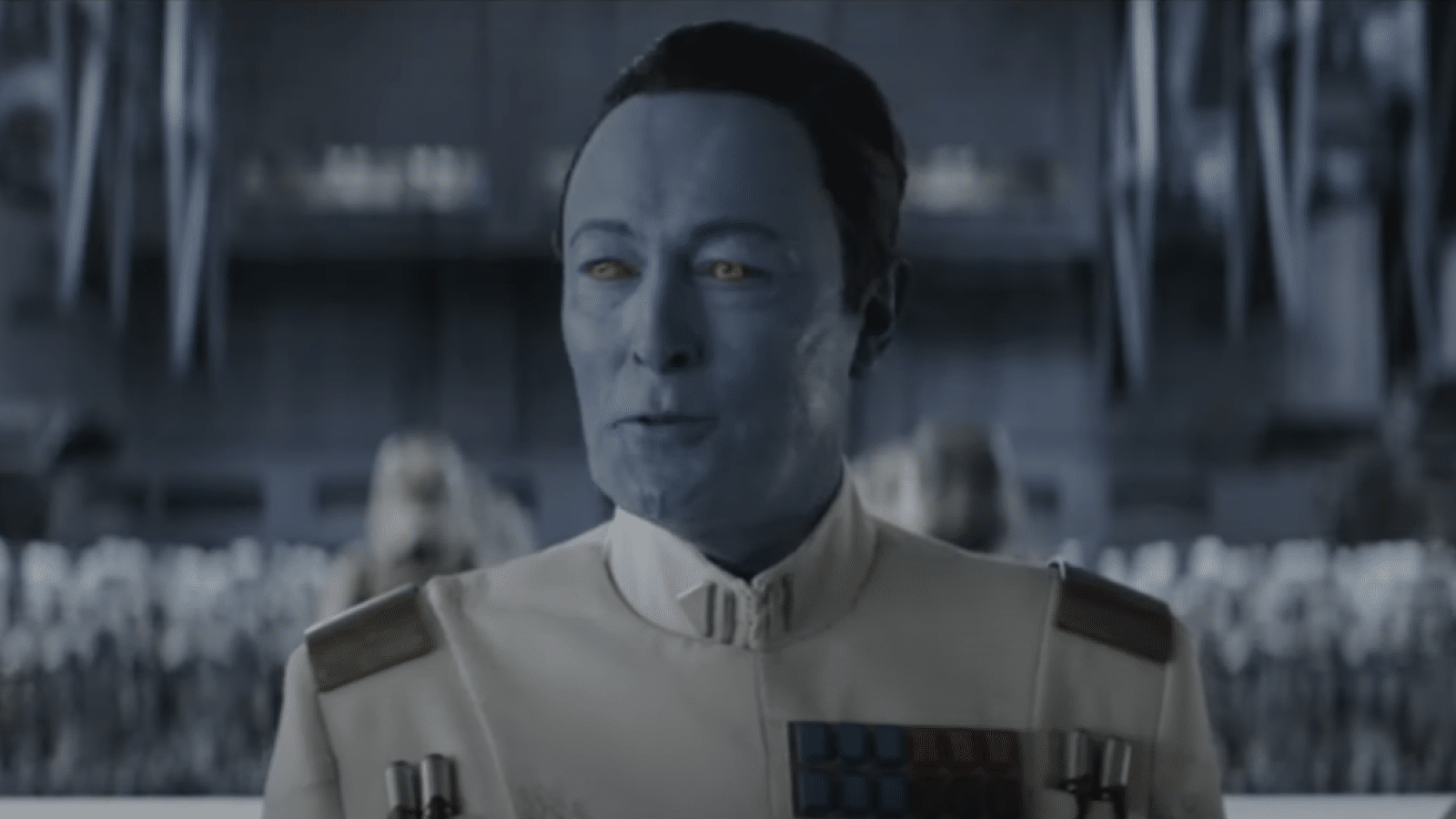Hot on the trail of the stolen hyperdrive engine, Sabine renews her Jedi training regime to frustrating results while Hera discovers the New Republic has a lot of the same problems as the Old one in Ahsoka episode 03, “Time to Fly”, directed by Steph Green and written by Dave Filoni.
“Time to Fly” is a short, relatively brisk (more on that below), action-heavy installment of Ahsoka. Even with their short episode orders, this isn’t the first time a Star Wars streaming series has done this sort of thing — The Mandalorian usually has at least one of this type of episode each season — but while the format isn’t that unusual, the relative brevity of “Time to Fly” nevertheless underscores something unusual about this series.
Plot-wise, not a ton happens here. Picking up where “Toil and Trouble” leaves off with Ahsoka and Sabine reunited in a formal master/apprentice relationship and hot on the trail of Morgan’s purloined hyperdrive engine, all that really happens in “Time to Fly” is that the pair arrives at Seatos, where the engine is, get in a fight, and land on the planet. Meanwhile, Hera tries to muster the support of the New Republic to march (or at least tentatively step towards) on Morgan and Thrawn, only to be met by the kind of mealy-mouthed response that we recognize from the last season of The Mandalorian and know will lead to the rise of the First Order in the Sequel Trilogy.
However, that slight plot makes way for three notable sequences. The first, in the episode’s opening stinger, involves an extended training sequence. Ahsoka takes a page from her old buddy Obi-Wan Kenobi’s playbook, and has Sabine train with a lightsaber while wearing a helmet which makes her effectively blind, a formal Jedi training technique called “Zatochi.” There’s a lot of fun tension in this sequence, as we wait to see whether Sabine will manage to tap into the Force and beat Ahsoka, simply hold her own on the strength of her natural abilities or lose her cool and explode, while the camera work helps make us feel some of her disorientation, with carefully placed cuts and zooms covering Ahsoka’s movements through the training space.
It works to establish a baseline for Sabine’s abilities, and also opens up the discussion about just who can and can’t learn to use the Force (ultimately, anyone, though there is something innate and unlearnable about being really good at it or doing it easily). The idea that, technically, anyone in the Star Wars galaxy could use the Force is something George Lucas has talked about in interviews for years, but which never really set in amongst some parts of the fandom, in part because it was never before discussed in-universe as explicitly as it is here.

The next notable sequence in “Time to Fly” is the extended dogfight between Ahsoka, Sabine, Shin, and Shin’s fighter pilot companions (including Marrok). While entertaining in its own right (including some more nods to A New Hope and a pretty badass sequence where Ahsoka goes extravehicular to duel a starfighter with her lightsabers), it also serves to illuminate Ahsoka and Sabine’s characterization and the state of their renewed partnership. Just as the action ebbs and flows, so too does their relationship, from one of pointed, barely-veiled barbs (Sabine is mad Ahsoka removed her turret gun presets; Ahsoka bites back, saying she never needed them) to one of mutually-appreciative teamwork, as the pair get better at communicating so Sabine’s gunnery and Ahsoka’s piloting can work hand-in-hand. It’s an expression of the arc of their relationship in space battle form, which helps make it more than just an action scene for the sake of action.
Finally, from there, the third standout moment is simply the appearance of the purrgil. First introduced in Rebels and teased briefly in the last season of The Mandalorian, purrgil are basically space whales with squid-like tentacles that travel through hyperspace. They’re one of the more bonkers concepts in Star Wars, and seeing them rendered in live action and factoring into the plot here is simply a kick.
Yet for all that, this episode is relatively slight in terms of plot advancement and built around an extended action sequence. That brevity underscores something notable about the series thus far: it seems oddly slow-paced. Not necessarily in terms of the plot (this is a bit of wheel-spinning episode, but not outrageously so relative to other series) or the presentation of the action (which is delivered as effectively as any other Star Wars streaming series), but in the delivery of dialogue and the scene transitions.
Characters pause for an extra beat or two between lines of dialogue, despite the dialogue not supporting the extra time. Scenes are held for a few extra seconds before they cut, as though they’re building to something dramatic that never comes. Ahsoka’s conversation with Sabine about the nature of the Force is paced like Ahsoka’s going to impart some kind of earth-shattering information, but ultimately, she doesn’t; it’s a relatively straightforward conversation about the nature of the Force and the importance of practice. The ending of the episode, with Baylan ordering troops into the woods of Seatos to find Ahsoka and Sabine, is a standard story beat, a low stakes but otherwise cromulent cliffhanger ending, but the camera lingers on him after he gives the order long enough to make us think something more (and something bigger) is coming, slowly zooming in as the score swells, before just cutting to black.
This kind of ponderous inter-scene pacing was present in the first two episodes as well, but “Time to Fly” makes it clear it’s a stylistic choice, and not a quirk of production, while the nature of the episode — with its otherwise fast-paced action — also makes it standout even more. What isn’t clear is why the series, and both its directors thus far, is utilizing this particular style, and whether or not it will become less of a distraction as time goes by.
Force Facts
- “Zatochi” is presumably a nod to Zatoichi, the blind swordsman of Japanese fiction.
- The idea that “train to fight while blind” is an established Jedi training technique explains why helmets with vision-obscuring visors exist in the Star Wars universe, but still doesn’t explain why Han had one on the Falcon.
- All the training sequences made me realize that Jedi masters could really use some Mister Miyagi-style training exercises in their teaching regimen. Everyone just talks to their students about doing vague things like “opening themselves up to the Force” which amounts to a lot of brow-furrowing before swinging a lightsaber and little else, vs. giving them practical actions they can perform that will help open them up. Basically, Ahsoka needs to make Sabine wax the spaceship in a way that turns out to be creating muscle memory for an important lightsaber technique or something.
- That is of course Genevieve O’Reilly reprising her role as Mon Mothma from Revenge of the Sith, Rogue One, and Andor, bringing an appreciated bit of continuity to the series.
- Senator Xiono, the jerk-ass senator that is the most vocal opponent of Hera’s desire to send a force after Thrawn, previously appeared in the animated Resistance, set shortly before The Force Awakens; he is the father of that series’ protagonist, Kaz Xiono, and is just as charming there as he is here.
- Editor Matt’s Note: Boy, but I wish we could have seen Timothy Zahn creation, Bothan Senator Borsk Fey’lya in the above scene. He would fit in with the whole ethos of adding characters from the Thrawn Trilogy, but this would mean visually canonizing Bothans, which the new canon Star Wars media seems averse to thus far.
- The “who is Marrok?” guessing game continues, with Galen Marek, aka Starkiller from The Force Unleashed video game, as the apparent current leading candidate amongst fans, thanks to the similarity in the characters’ names, the fact that Dave Filoni mentioned in the past a desire to canonize Starkiller and make him an Inquisitor, and the fact that Sam Witwer, who was the voice & body template for Starkiller in the game (as well as the voice of animated Darth Maul), has been listed in the credits of Ahsoka for no as yet apparent reason.
Elsewhere in a Galaxy Far, Far Away

From a Certain Point of View: Return of the Jedi was released this week. I haven’t had a chance to read it yet, but I’ve dug the previous “Point of View” volumes, which feature a collection of short stories that offer a different perspective on various characters, moments, or plot points in their respective Star Wars films, and am excited to dig into this one. Of particular note is a story from Saladin Ahmed about the character with perhaps the most pathos in the movie, the Rancor keeper in Jabba’s palace, as well as a story from Charlie Jane Anders told from the perspective of everyone’s favorite bounty hunter-eating space sand vagina tentacle monster, the Sarlaac.
This Week in Star Wars History

The Star Wars #1, the first issue of a non-canonical comic book adaptation of George Lucas’ first draft of Star Wars, is published on September 4, 2013.
Austin Gorton also reviews older issues of X-Men at the Real Gentlemen of Leisure website, co-hosts the A Very Special episode podcast, and likes Star Wars. He lives outside Minneapolis, where sometimes, it is not cold. Follow him on Twitter @AustinGorton






